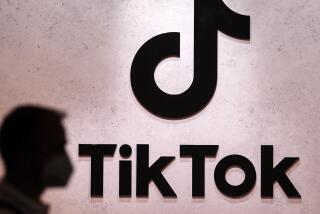YouTube Kids app exposes children to too many ads, some groups say
YouTube’s big push into kids’ programming is under scrutiny for blurring the lines between entertainment and advertising.
A string of children’s advocacy groups planned to file a complaint Tuesday asking the Federal Trade Commission to investigate whether the newly launched YouTube Kids app is exposing young audiences to an unwanted barrage of commercials.
The app, which rolled out in February, enables kids to choose from hundreds of channels to watch entertainment and educational programs. But mixed into the offerings are branded content from corporate giants such as McDonald’s, Mattel and Hasbro.
The coalition of advocacy groups, which includes Campaign for Commercial Free Childhood and the Center for Digital Democracy, contends that that violates federal laws in place since the 1970s that limit how advertisers target young children. The crux of those rules protect kids who can’t distinguish between commercials and entertainment.
“This is the most hyper-commercialized media for kids I have ever seen,” said Dale Kunkel, a University of Arizona professor specializing in children’s media who helped draft the FTC complaint. “Children don’t understand the persuasive intent of advertising.”
The coalition wants the FTC to “stop these and any other deceptive or unfair practices uncovered as a result of its investigation.” The complaint marks one of the first times that advertising regulations are being used to monitor how digital programming is presented.
Commercials on YouTube, which is owned by Silicon Valley giant Google, follow a typical format. Advertisers get 30- to 60-second spots that run ahead of videos that users select.
But regulations put in place by the Federal Communications Commission put extra protections on children’s TV shows.
For instance, networks are prohibited to use “host-selling,” which means they can’t make deals with advertisers in which their products are pitched during shows using a character in the program. There are also rules that require kids’ shows to clearly define when a commercial break is coming up. The rules gave rise to phrases such as “Now a word from our sponsor” and “We’ll be right back after these messages.”
The complaint pointed out the McDonald’s channel on the YouTube Kids app as a problematic example because it features traditional TV-style ads as well as content segments “that are really promotions for McDonald’s products.”
Asked about the complaint, a YouTube spokeswoman said: “We worked with numerous partners and child advocacy groups when developing YouTube Kids. While we are always open to feedback on ways to improve the app, we were not contacted directly by the signers of this letter and strongly disagree with their contentions, including the suggestion that no free, ad-supported experience for kids will ever be acceptable. We disagree and think that great content shouldn’t be reserved for only those families who can afford it.”
The complaint was filed by the Center for Digital Democracy, the Campaign for a Commercial-Free Childhood, American Academy of Child and Adolescent Psychiatry, Center for Science in the Public Interest, Children Now, Consumer Federation of America, Consumer Watchdog, Consumers Union and Public Citizen.
Ahead of the app’s launch, YouTube emphasized that the app is family friendly. The company also pointed out that parents are able to control how much time their kids spend on the app, and also monitor what they are watching.
YouTube also screens all advertising that is aired on the app to make sure it’s family friendly. Before the app went live, the video sharing network received endorsements from content creators and advocacy groups, such as Common Sense Media and the Family Online Safety Institute.
Malik Ducard, YouTube’s global head of family and learning, said in an interview last month that the idea for the app stemmed from the popularity of the family entertainment genre. He said the number of viewers looking at children’s programming on YouTube has surged 200% in the last year.
“It was made in a way that’s easy for kids to understand and navigate,” Ducard said in an interview following the app’s release. “With big, colorful, swipeable buttons designed for little pudgy fingers.”
Technology is already a touchy subject with parents, with some employing it as an educational babysitting tool and others labeling it a potentially dangerous playmate.
The American Academy of Pediatrics doesn’t recommend screen time for children under age 2. Still, an estimated 70% of kids 2 to 5 in the U.S. use tablets, according to a study conducted by advertising consulting firm Communicus.
More views in the digital space translates into more interest from advertisers.
Advertisers “can reach an audience that mostly consumes media online and on mobile,” said Chris Baccus, executive director of digital at Golin, a public relations firm that specializes in consumer marketing. “There is also the ability to lead people from one digital experience to the next with clickable links.”
The financial incentives are evident. Parents spend up to about $15,000 a year on their kids for items including food and clothes, according to a report published last year by the U.S. Department of Agriculture. A report in 2012 from marketing firm Digitas suggested the generation that follows millennials (kids and tweens) can influence up to $1.2 trillion in spending a year.
These kind of metrics has led to high interest from Hollywood.
As the consumer appetite for online videos continues to grow, so does the number of entertainment apps aimed at kids. Hollywood has been rapidly racing into the kids digital market by boosting online content and partnering with digital entertainment networks.
PBS, home to classic kids’ programming such as “Sesame Street,” which generations of children have grown up watching, launched its free PBS Kids Video App for the iPad in May 2011, iPhone and iPod touch in December 2011 and Android in June 2014.
The app enables kids to browse through popular PBS content through a side bar with clickable images of shows such as “Arthur” and “Thomas & Friends.” Parents can also get additional information for any show on the network, such as the synopsis, target age range and educational goals. The network said its PBS Kids app has had more than 8 million downloads.
Nickelodeon has its Noggin and Nick Jr. apps, directed at preschool-aged children and featuring popular shows such as “Dora the Explorer.” Some clips from the network’s shows, including “SpongeBob SquarePants,” are also available on YouTube Kids.
Disney Channel also has an app with bite-size content including “Mickey Mouse” shorts. The Burbank-based entertainment giant bought YouTube network Maker Studios last year in a deal worth up to $950 million to boost its presence in the digital space.
But one of Maker Studios’ popular channels, EvanTubeHD, was mentioned in the FTC complaint as a type of channel that fails to adequately separate program and commercial material. According to the complaint, some EvanTubeHD videos consist of an “off-camera adult voice engaging the charming youngster as he reviews toys with an infectious mix of enthusiasm and wonder.”
Not everyone is opposed to the surge in digital entertainment apps.
“Screens are everywhere now. It’s unrealistic to think we’re going to keep kids away,” said Tanya Altmann, an L.A.-based pediatrician who has served on the executive board of the American Academy of Pediatrics’ Committee on Communications and Media. “But it’s important to choose the content and screen time wisely.”
For Pattie Cordova, tablets are the only devices from which her sons Logan, 7, and Luca, 3, consume content.
“I downloaded the kids’ app because I knew that my kids would be able to safely watch YouTube without bad advertisements,” Cordova said. “It looks like YouTube did the research on what kids want because the app is completely tailored to them.”
Logan, who is in first grade, echoed his enthusiasm for the app, especially for the “Minecraft”-related videos available in the searchable library.
“You can create your own world with the videos,” he said.
More to Read
From the Oscars to the Emmys.
Get the Envelope newsletter for exclusive awards season coverage, behind-the-scenes stories from the Envelope podcast and columnist Glenn Whipp’s must-read analysis.
You may occasionally receive promotional content from the Los Angeles Times.











